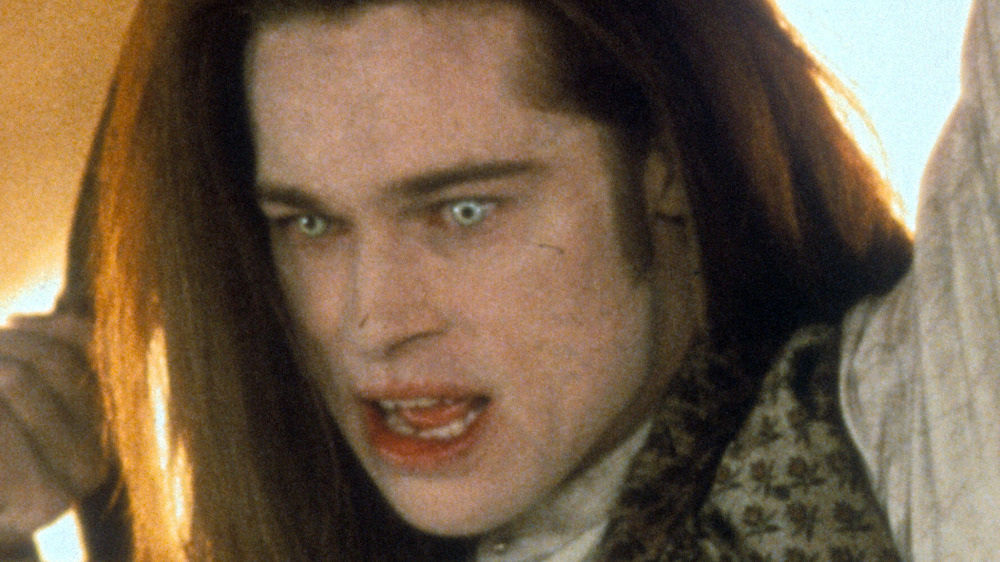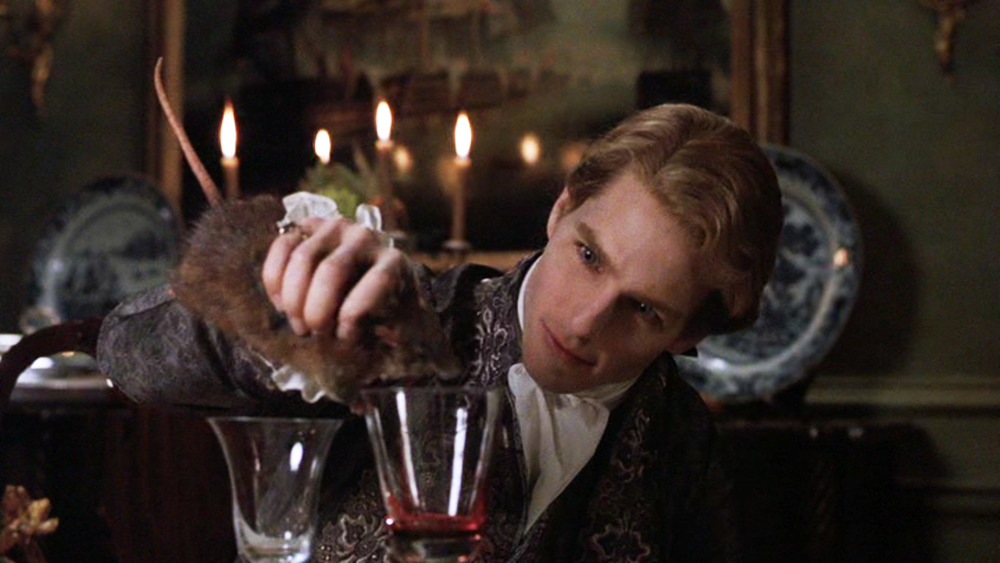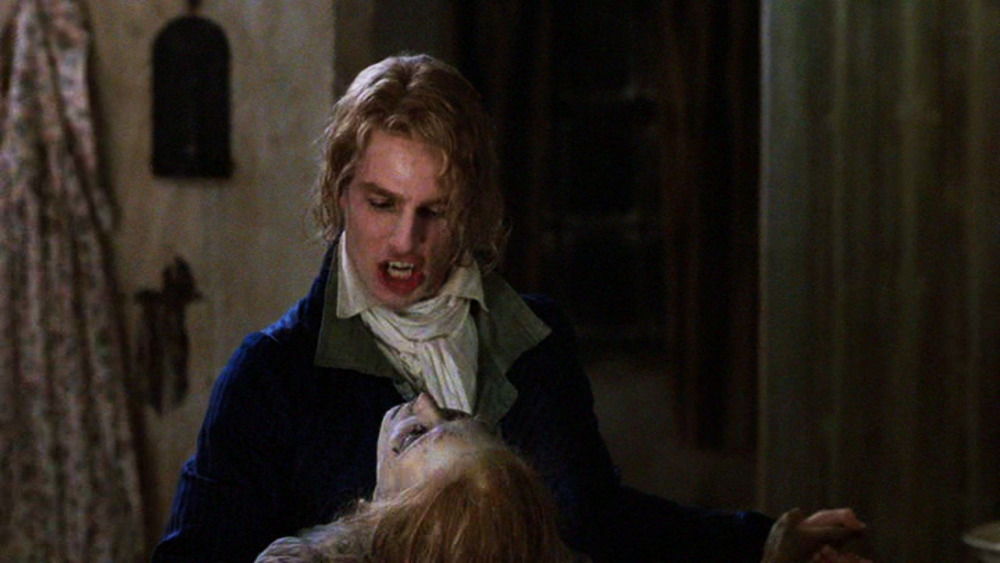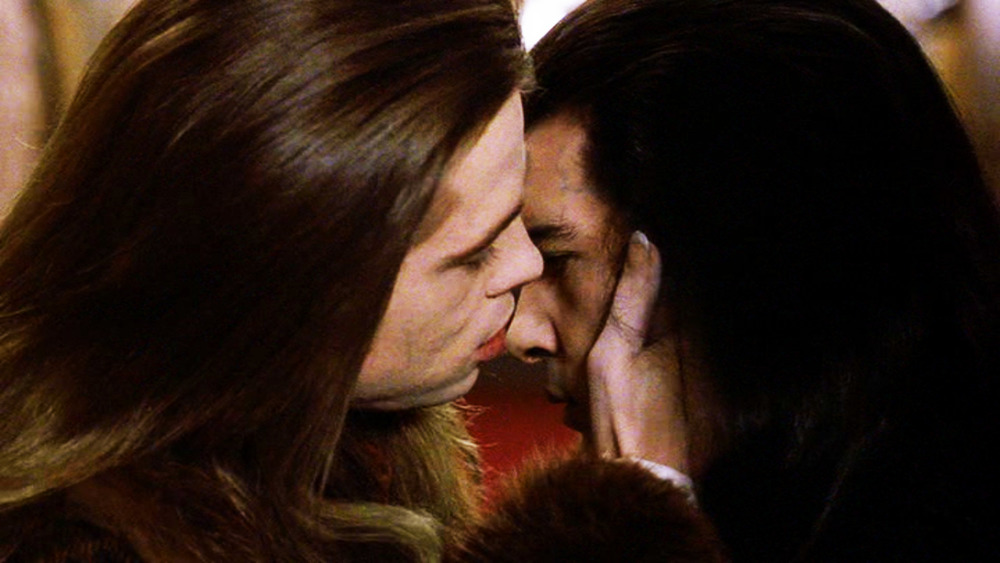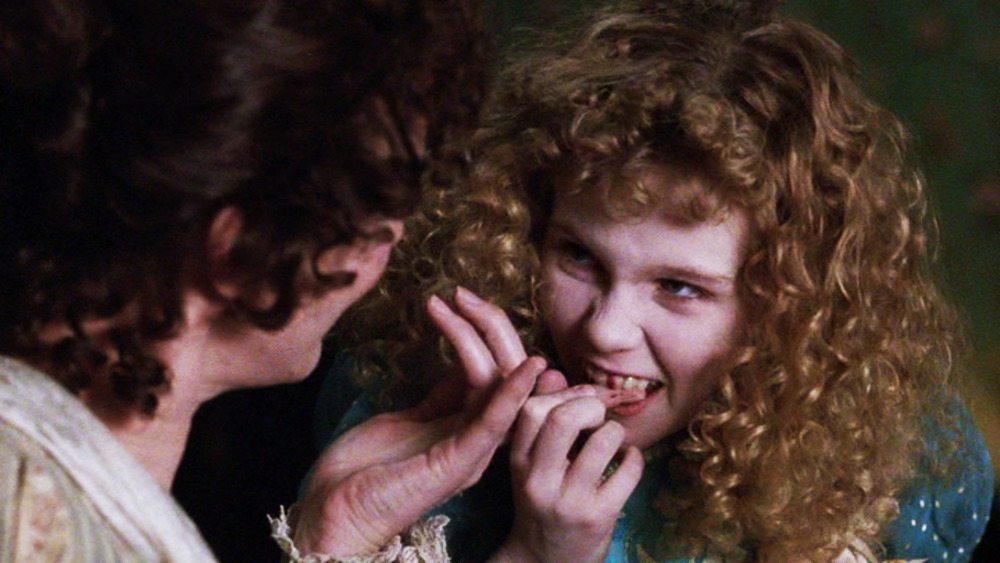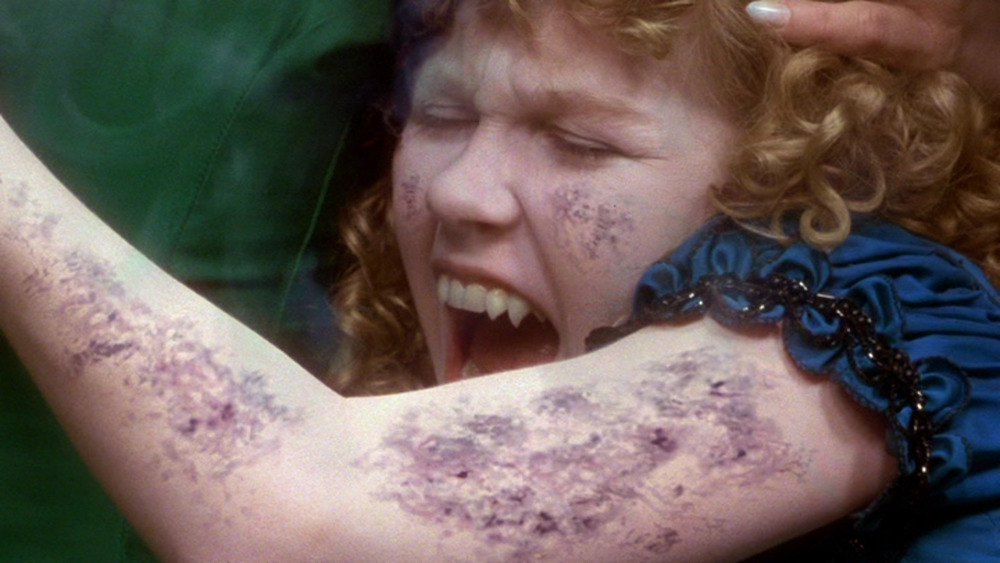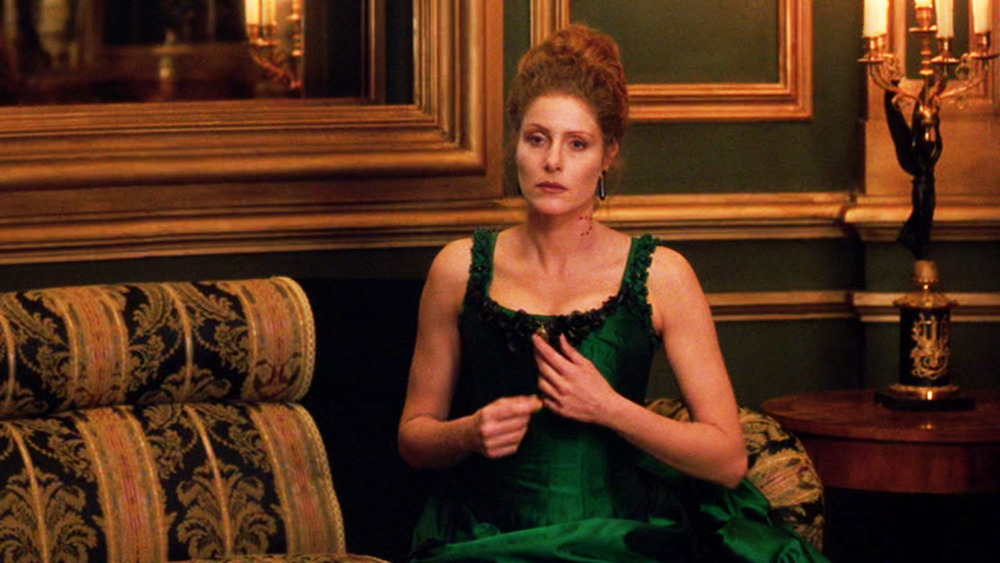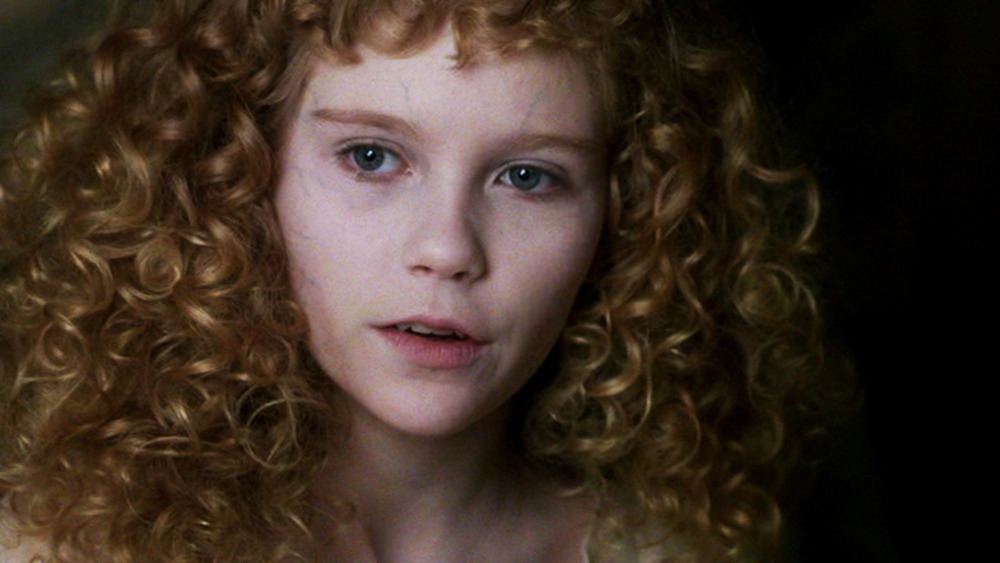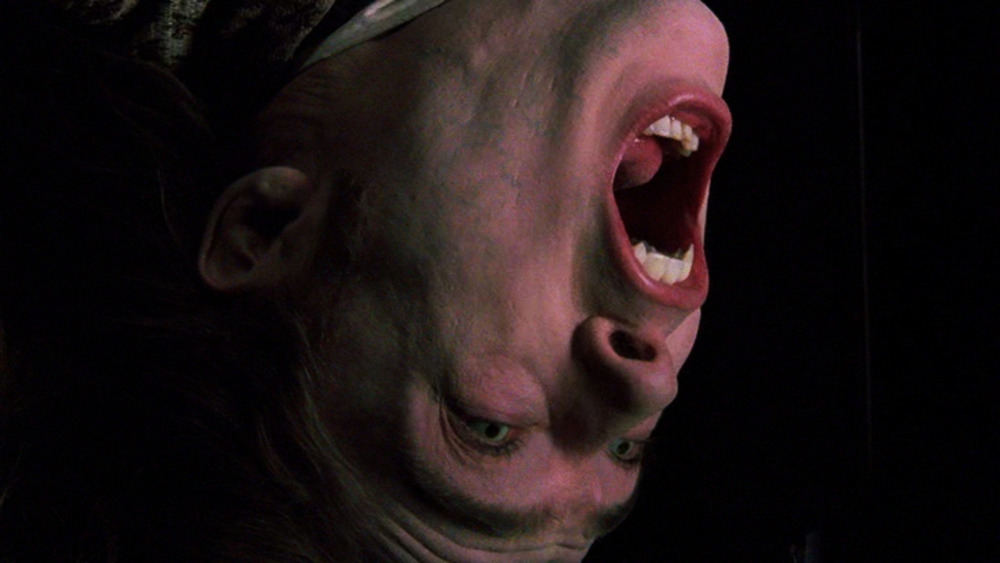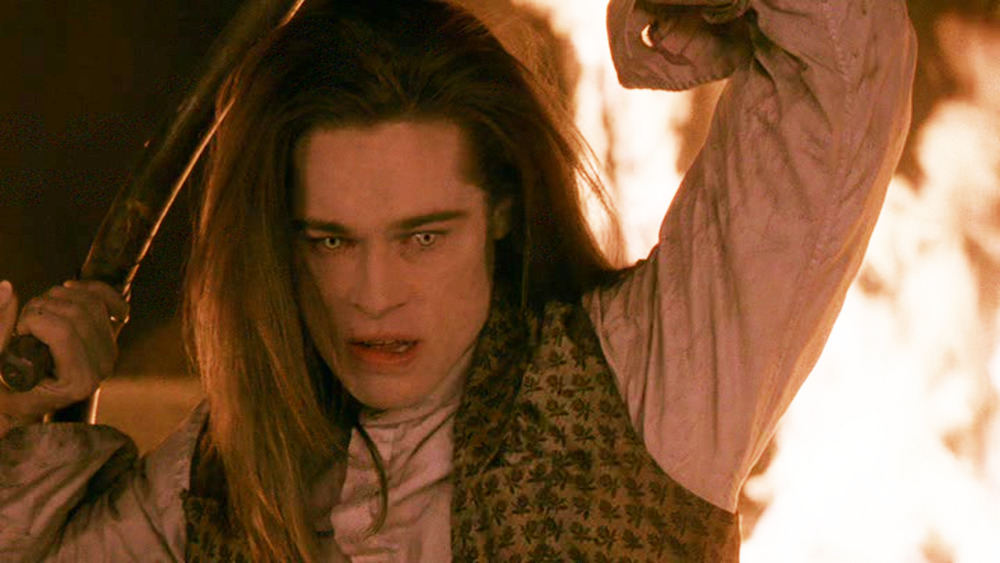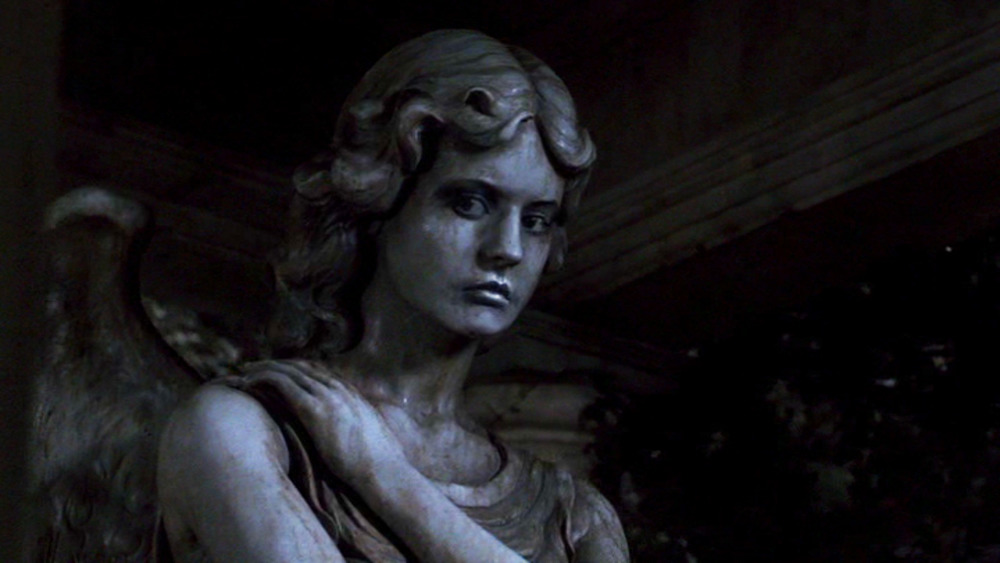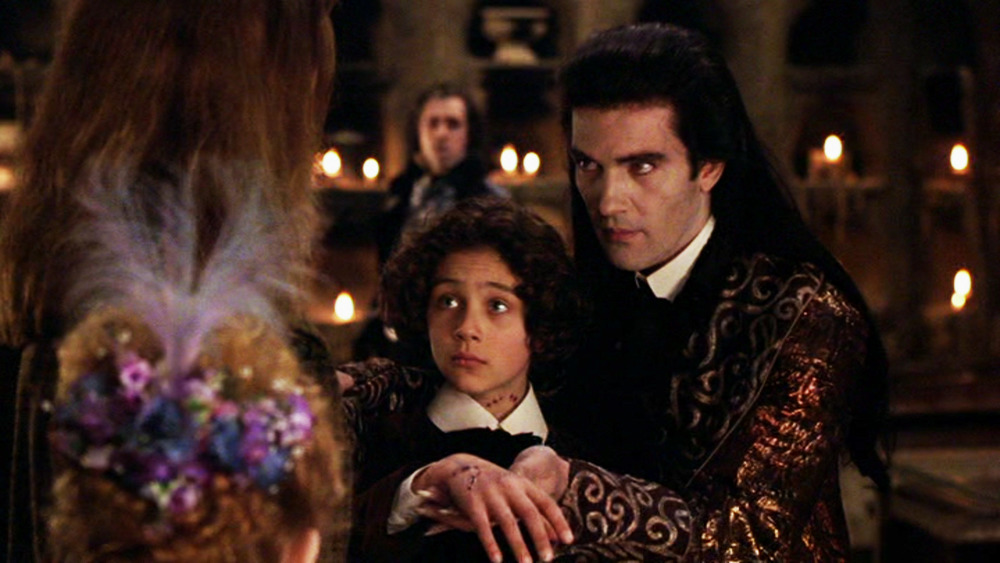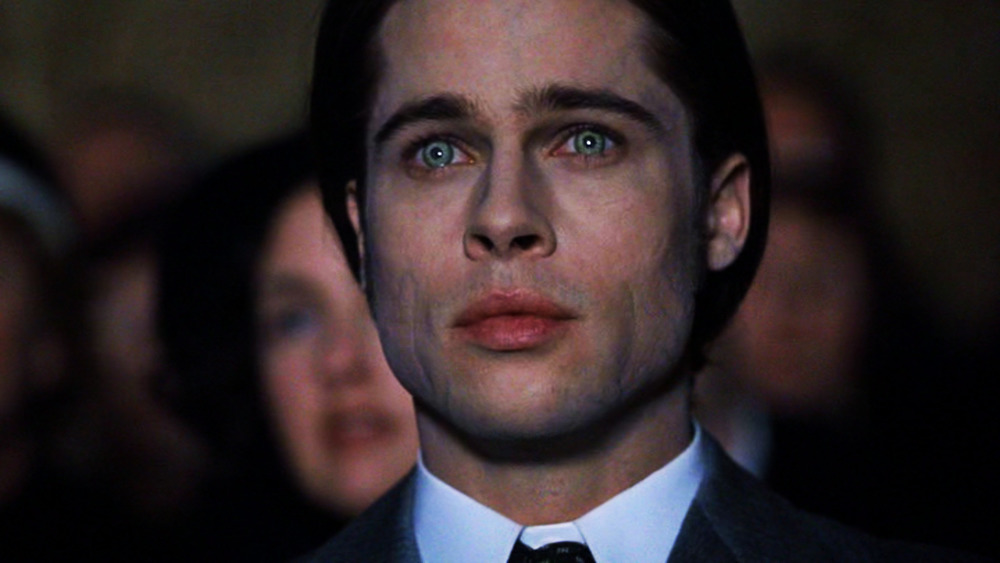Things You Forgot Happened In Interview With The Vampire
It's been 45 years since the publication of Anne Rice's Interview with the Vampire, one of the most well-known vampire stories in modern literature. Possibly better known than the book, however, is the 1994 film adaptation, a famously imperfect cult classic with a screenplay by Rice herself that starred Brad Pitt, Tom Cruise, and Antonio Banderas. The film also launched the career of 11-year-old Kirsten Dunst, whose performance as the child vampire Claudia is bone-chilling. It was a huge box office success, ending up as one of the biggest hits of 1994 and breaking the record, at the time, for biggest opening weekend for an R-rated movie. A whole lot of people saw this film...even if they might not remember the details.
Interview with the Vampire is not a great movie. Viewers likely remember it chiefly for Dunst's incredible performance, or for the correspondingly mediocre efforts of both Pitt and Cruise, neither of whom put in their best work. But while you might remember the big scenes — Lestat (Cruise) biting Louis (Pitt) for the first time, or the dramatic execution by sunlight — you've probably forgotten the smaller and arguably more interesting elements. With that in mind, here are a few reminders of some of the weird stuff that happens in the movie.
Incidentally, we are about to spoil pretty much the entirety of Interview with the Vampire, so if you haven't seen it, dramatically turn your face away now!
Somebody call vampire PETA
If there's one thing you come to a vampire movie knowing you're going to see, it's humans getting their blood drained, and Interview with the Vampire does contain a reasonable amount of that. Far more common, however, is a scene involving the discarded, bloodless corpse of some kind of animal. When Louis first becomes a vampire, he rejects the idea of killing humans to sustain himself, despite Lestat's attempts to convince him. He subsists primarily on animals for the first part of the film, mainly consuming the blood of rats and chickens. In one scene, Lestat kills a rat for him and twists it in his hands, squeezing its blood into a goblet like he's making homemade orange juice. In another, Louis seduces an elderly aristocrat with the intent of feeding on her, but ultimately settles for her poodles instead.
Of course, the film establishing that vampires can survive off animals if necessary comes back, ironically, to help Lestat, who tells Louis and Claudia that he survived their initial attempt to kill him by feeding on alligators and other creatures living in the swamp to which they had consigned his body.
Lestat's danse macabre
This is a small thing, but it's strangely important to the movie. After trying to live as a vampire without killing humans, Louis encounters a young girl crying over the long-dead corpse of her mother. As Louis tries to comfort her, she throws her arms around his neck, and he can't resist the temptation any longer. He feeds on her and kills her, finally giving in to his monstrous vampire nature.
And then Lestat arrives, and he's jubilant. Mocking Louis for his professed morality, he proclaims, "This calls for a celebration." He pulls the corpse of the girl's mother into his arms and begins gleefully dancing her around the room. "There's still life in the old lady, yet!" he shouts, while Louis flees the scene in a fit of horrible guilt.
Not only is this a delightfully macabre moment from Lestat, but it beautifully illustrates the difference between his attitude toward humans and Louis'. It represents a gap in their ideologies that can never be bridged...which is why Lestat, in an effort to make Louis stay with him, transforms his young victim into the vampire known as Claudia.
There's way more sexual tension than you remember
You sometimes hear about how the queer subtext of Interview with the Vampire was toned down because, you know, it was 1994. And sure, a version of this movie made today would likely be more explicit. But there's a ton of sexual tension simmering between almost every major character hidden just beneath the surface — when they bother to hide it at all.
Lestat turns Louis into a vampire because he finds him beautiful (actually, everybody in this movie finds Louis beautiful, presumably because it's Brad Pitt). But the two characters have about as much chemistry together as their actors do. So Lestat creates Claudia, and while they both fall in love with her, Claudia prefers Louis. Despite the fact that they refer to one another as father and daughter, they are clearly lovers, as Banderas' Armand points out. Their final moment together involves Claudia calling Louis "father" before kissing him on the mouth.
Armand and Louis later become infatuated with each other, leading Claudia to accuse Louis of cheating on her. After her death, Louis "breaks up" with Armand in a highly sensual scene that involves Louis' lips being extremely close to Armand's face. Even at the end, when Christian Slater's radio journalist asks Louis to make him a vampire, Louis responds by aggressively choking him and demands, "Do you like this?" You could write a book on the sexual metaphor that is Interview with the Vampire, regardless of its release date.
Stephenie Meyer probably saw it a couple times
The author of the Twilight series engaged in a brief media feud with Anne Rice in 2011, and claimed at one point that she had never seen Interview with the Vampire in its entirety. "I've seen little pieces of Interview with a Vampire when it was on TV, but I kind of always go YUCK!" Meyer said. And yet, is it really likely she hasn't seen the film, considering the similarities between Interview and Twilight?
Rice's vampires might not sparkle in the sunlight, but some of them do have superhuman abilities just like Meyer's characters. Lestat can read the thoughts of humans, and in Paris, a vampire named Santiago (played by Stephen Rea in the film) reads Louis' mind, as well. "The dark gift is different for each of us," Lestat says when Louis confesses he doesn't have this power. In Twilight, some vampires have unique special powers, and one of Meyer's main characters, Edward Cullen, has the power to read minds. He also possesses a brooding melancholy, centered on his own monstrousness, that is very similar to Louis' personality, making Edward a literary descendant of both Louis and Lestat.
Additionally, a major plot point in Twilight is the past existence of "immortal children," vampires turned while they were children in a practice that has since been outlawed. This also seems to mirror Claudia, who demonstrates the danger of combining a child's demanding nature with a vampire's bloodlust, and whose creation Armand likewise says is forbidden.
Claudia was technically innocent of her crime
One of Interview's most memorable scenes is Claudia's death, when the Parisian vampires trap her in a room with an open ceiling and allow her to burn when the sun comes up. There are a few reasons this might have occurred — as mentioned, it's forbidden to create a vampire child, and Armand definitely wanted her out of the way so he could have Louis all to himself. But the explicit reason for her execution is that she broke the cardinal rule of vampire society: She killed another vampire. We learn about this law from Santiago, whose mind-reading powers have picked up on Louis' regret over what he and Claudia did to Lestat before leaving New Orleans, and Santiago is the one who sentences her.
But Claudia didn't actually do what she was punished for doing. For one thing, while Claudia did feed Lestat poisoned blood and slit his throat, he came back to get his revenge before Claudia and Louis could leave the country, forcing Louis to light him on fire. So it was really Louis who killed Lestat, not Claudia. And for another thing, Lestat still wasn't dead, as we learn later when Louis discovers him back in New Orleans over a century later. You'd think that if Santiago was any good at mind-reading he would have picked up on that. But of course, Claudia was doomed in any case, from the moment Armand laid eyes on Louis.
Madeleine's short career as a vampire
You might have vivid memories of Claudia screaming and steaming as the sunlight touched her skin and turned her to ash, but did you remember that someone else was in the room with her? The character of Madeleine (Domiziana Giordano) doesn't have much time to make an impression — she's executed along with Claudia almost immediately after being turned into a vampire by Louis. But what little we get of her is actually really interesting, and makes it a bit of a shame that she isn't in the movie more.
We only know a few things about Madeleine: She works in a shop that sells dolls (a symbolic link to the doll-like Claudia), she's extremely willing to be turned, and she carries a portrait of a young girl around her neck. It's heavily implied that the girl is Madeleine's deceased daughter. Claudia, a girl who lost her mother and is trapped in a child's body forever, wants Madeleine, a mother who lost her daughter, to become a vampire and play the role of Claudia's eternal mother — or at least that's what she probably told Madeleine. Claudia's jealousy of Armand and certainty that Louis is leaving her likely played a role in her motivations. But Madeleine is extremely willing to go along with Claudia's plans. Indeed, she's the only vampire in the movie who makes an informed choice to join the ranks of the undead. She's fascinating, and it would have been nice to get more time with her.
The significance of Claudia's hair
Claudia's hair is a one of the most important symbols in Interview with the Vampire. When we first meet her, her hair is dirty and disheveled, the hair of a child living in plague and poverty. Upon transforming into a vampire, Claudia becomes suddenly beautiful, and her hair becomes a mass of shining golden curls. Those curls are a symbol of her newfound immortality, but they're also a symbol of her inability to change, the stagnation brought about by the fact that she will never grow old or die. This symbolism is driven home in the scene where Claudia, desperate to prove that something in her life can be changed, cuts off all her hair in a show of defiance...only to see it instantly grow back. There is no escape from the world she has entered or the thing she has become.
Even after her death, Claudia's hair remains significant. Throughout the movie, vampires like Lestat and Armand marvel at Louis' passion and respect for life, reflected in his distaste for killing humans and his love for Claudia. At the end, Louis explains how he lost all of that when he lost her, saying "All my passion went with her golden hair."
Louis gets bricked up behind a wall
What's Louis doing the whole time while Claudia is being burnt to ash, you ask? Well, it's pretty simple: He's busy being turned into a permanent resident of the theater walls. Or so he thinks. While Claudia and Madeleine are forced to take in a beautiful sunrise, Louis is given a different sentence. "Eternity in a box," as Santiago calls it. He and the other Parisian vampires lock Louis in a coffin, stick the coffin in a stone nook beneath the theater, then literally build a wall to seal him in. It's very reminiscent of the 1846 Edgar Allen Poe short story "The Cask of Amontillado," in which the narrator builds a wall of bricks and mortar to immure a former friend for an unknown crime.
It's easy to forget that Louis is essentially buried alive (or buried undead, rather) during Interview, because it doesn't last very long. Armand frees Louis immediately after Claudia's death, suggesting that, despite his protests to the contrary, he just needed Louis out of the way long enough for Claudia to die. But it is an effective moment that tends to get lost amid the film's more memorable depictions of iconic horror.
Louis is a serial arsonist
Vampires traditionally have a complicated relationship with fire, which makes it all the more interesting that Interview is structured around three instances of Louis burning down a building. The first one is his plantation house in Louisiana, just after he's killed the slave girl Yvette (played by a 22-year-old Thandie Newton). In an attempt to reject Lestat and the monstrous life of a vampire, as well as deal with the mob of superstitious slaves surrounding the house with torches, Louis opts to burn the place down himself, putting an end to his and Lestat's opulent lifestyle.
Louis burns his own house down again later on, after Lestat returns on the eve of his former lovers' departure to take his vengeance on Claudia for trying to kill him. Louis saves her by shattering a lantern at Lestat's feet, causing him and the home the three of them had shared together to go up in flames. And after Claudia dies at the hands of the Parisian vampires, Louis takes his own revenge, dousing their coffins in oil while they sleep, killing any who attempt to rise, screaming, from their fiery graves, and burning their decadent theater to the ground.
Wait, was that statue just looking at me?
After turning Louis into a vampire, Lestat tells him to "look with your vampire eyes." One of the first things Louis sees is a statue of an angel — only now, the angel's stone eyes are unsettlingly alive, its gaze following the camera. "The statue seemed to move, but didn't," Louis says. "The world had changed, yet stayed the same. I was a newborn vampire, weeping at the beauty of the night."
Beyond the fact that "the world had changed, yet stayed the same" feels like another part of the vampirism-as-sex metaphor, there's something weird going on here that's never fully explained. What does it mean that the statue moved, but didn't? It would be one thing if Louis, say, saw colors differently as a vampire, but he's seeing an inanimate object come to life and stare at him. Why? This plot point is never explained and never comes up again — no other element of the film involves vampires sharing some kind of unique form of sight. And while this is mostly incidental, it's hard for anybody who watches Doctor Who to just sit there and ignore the fact that a statue of an angel is coming to life moments before Louis uses the word "weeping." Granted, Interview with the Vampire precedes the existence of the Weeping Angels by 13 years, but still, it's creepy.
Who is Bite Mark Boy?
Another thing that's never explained is the identity of the young boy who is often seen hanging around Armand in Paris. When Louis is first introduced to the Parisian vampires, Armand asks him to try a little of the boy's blood, and it's clearly not the first time — the kid has bite marks all over him. Some kind of introductory ritual, maybe? It doesn't come up again. The only other time we see Bite Mark Boy is immediately after Louis burns down the theater and kills all the Parisian vampires. Since he had to attack while they were sleeping, he's unable to leave before sunrise, and begins to burn. But a coach pulls up and Armand pulls him inside, rescuing him, with the boy driving.
The Interview with the Vampire novel actually gives Bite Mark Boy a name, Denis, and explains that he's Armand's personal attendant, basically a human pet. Which is all well and good, but it seems like a strange choice to include this character in the movie at all if we're not going to get anything resembling an explanation for why he's just hanging out waiting for new vampires to arrive in Paris to bite him. Especially considering the whole sex metaphor thing. Though admittedly, it's worth it for the moment when Louis has to turn Denis' arm over a couple of times, looking for a blank patch of skin where he can put some new fang holes and avoid...vampire germs?
Louis goes to the movies
Interview with the Vampire is a subtly self-aware movie in some ways, mostly involving the ways in which the vampire legend is presented to the public. Possibly the film's single most memorable scene involves a performance at the Théâtre des Vampires, the theater in Paris where Armand and his coven live. It's also a place where the Parisian vampires find ironic employment by putting on plays for humans about vampires. The moment when Armand and his followers drain the blood from a naked girl while her fellow humans look on and applaud is burned into the retinas of 1994 moviegoers.
What you may have forgotten, though, is that near the end of the film, upon Louis' return to America, he starts going to the movies. The birth of cinema allows Louis to see the sun for the first time in centuries, and the first films he sees are singularly appropriate — F.W. Murnau's Nosferatu and Sunrise: A Song of Two Humans. He also appears to have taken in D.W. Griffiths' Birth of a Nation and Victor Fleming's Gone with the Wind. The last two films he's seen attending are appropriate for a different reason: Superman: The Movie and Tequila Sunrise were both distributed by Warner Bros, the studio behind Interview with the Vampire itself.
